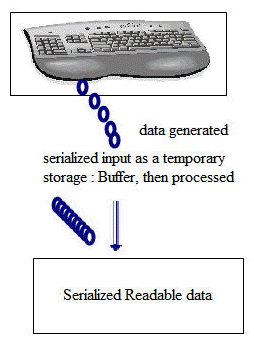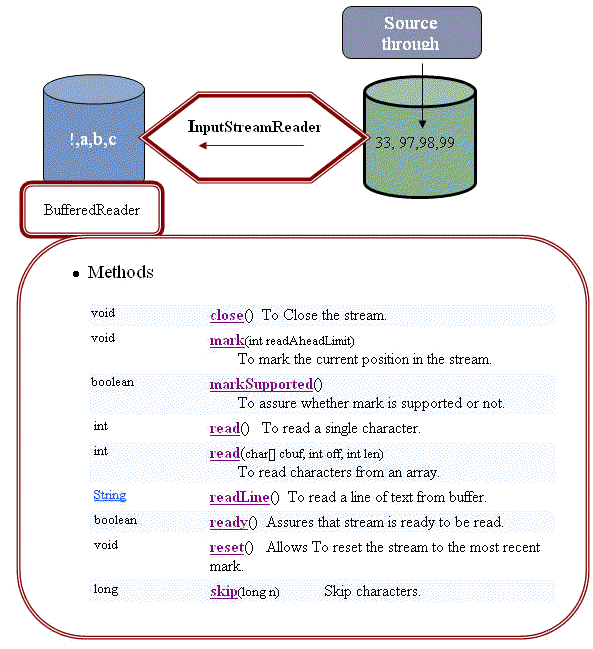
- A program opens a stream to a "data sink" where all the data reside.
- A file is an example of a data sink.
- A program opens a stream to allow data to be read into the routine or to be written "as data out to the file"
Types of Data
- Character : stored with in a file with a suffix of Reader or Writer.
- Raw Data : is saved to a data sink as bytes.
- Formatted data : an image file is stored as formatted data.
- Compressed Data
- I/O Streams
- Byte Streams: carries integer values of the data added as an input. (1), ranging a value 0-255 and 32 being a blank or space between two data during serialization. All byte stream classes are the descendents of
InputStreamandOutputStream(Read More). Java uses byte streams to perform input and output of 8-bit bytes. These classes are abstract classes, therefore can't be stream directly.
- FileInputStream in = null;
- FileOutputStream out = null;
- I/O byte streams,
FileInputStreamandFileOutputStream.- Character Streams: Any kind of text data handled by this stream. All character stream classes are descended from
ReaderandWriter.(Read More)
- FileReader inputStream = null;
- FileWriter outputStream = null;
- Buffered Streams: the efficiency of the streams mentioned above, further enhanced with Buffered stream.
- There are four buffered stream classes used to wrap FileReader or Writer streams:
- Create buffered byte streams:
BufferedInputStreamandBufferedOutputStream- Create buffered character streams
BufferedReaderandBufferedWriter.- Scanning and Formatting
- Scanning
- Formatting
- I/O from the Command Line
- Data Streams: support binary I/O of primitive data type values like
boolean,char,byte,short,int,long,float,doubleand Strings. All data streams implement either thetwo interfaces namely DataInputor theDataOutputinterface. This section focuses on the most widely-used implementations of these interfaces,DataInputStreamandDataOutputStream.- Object Stream
- File I/O
File Objects
Random Access Files
The New I/O Packages
Each invocation of one of an InputStreamReader's read() methods may cause one or more bytes to be read from the underlying byte-input stream. To enable the efficient conversion of bytes to characters, more bytes may be read ahead from the underlying stream than are necessary to satisfy the current read operation.
For top efficiency, consider wrapping an InputStreamReader within a BufferedReader. For example:
BufferedReader in = new BufferedReader(new InputStreamReader(System.in));
Types of Data Sinks: :Data sink streams read from or write to specialized data sinks such as strings, files, or pipes. Typically, for each reader or input stream intended to read from a specific kind of input source, java.io contains a parallel writer or output stream that can create it. The following table gives
java.io's data sink streams.
Sink Type Character Streams Classes Byte Streams Classes DataSink Classes Memory CharArrayReader,
CharArrayWriterByteArrayInputStream,
ByteArrayOutputStreamByteArrayInputStream,
ByteArrayOutputStreamStringReader,
StringWriterStringBufferInputStreamPipe PipedReader,
PipedWriterPipedInputStream,
PipedOutputStreamPipedInputStream,
PipedOutputStreamFile FileReader,
FileWriterFileInputStream,
FileOutputStreamFileInputStream
FileOutputStreamNote that both the character stream group and the byte stream group contain parallel pairs of classes that operate on the same data sinks. These are described next:
The Character Filter Classes can be stacked on top of another data sink.
Sink Type Character Filter Classes Buffer BufferedReader,
BufferedWritercharacters are stored in buffer and that can enhance performances of a routine. Line Counting LineNumberReader : can be used to read lines from a data while indexing the line numbers. Conversion InputStreamReader
InputStreamWriterPrinting PrintWriter can be used to print information to a source or computer screen Data Filter Classes:
Sink Type Data Filter Classes Compression GZIPInputStream,
GZIPOutputStream,
ZIPInputStream
ZIPOutputStream,
JARInputStream
JAROutputStreamObject ObjectInputStream,
ObjectOutputStreamBuffer BufferedInputStream
BufferedOutStreamPrinting PrintWriter
Sink Type I/O Exceptions Class Hierarchy


